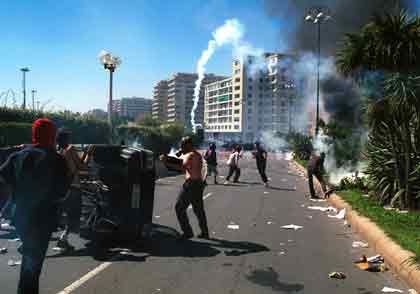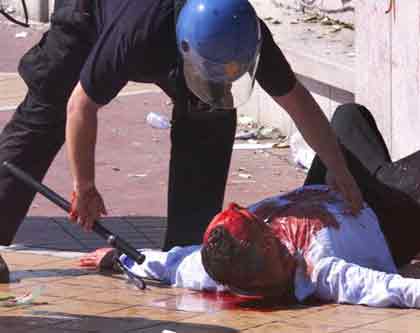 |
Home | SchNEWS OF THE WORLD -
Genoa Eyewitness Accounts
DAY THREE - SATURDAY JULY 21ST

Sight For Sore Eyes
On the third day was the 'International March'. This march was
to be the big, non-confrontational event. Big it was - 200,000 -
but with the police having assassinated a protester the day before,
it was bound to be a bit edgy...
"Although this march was supposed to be completely non-confrontational,
and in spite of the relaxed mood of the morning, there was a lot
of tension on the march. As well as the sizable numbers of people
with white-painted hands, there were a lot of people carrying sticks
(and thousands more carrying red flags). Every time a police helicopter
flew overhead (at least every five minutes), the chant of 'Assassini'
would go up from hundreds of voices, and a wave of arms would go
up to give the police the finger.
Really though, the most memorable thing about the march was its
sheer size (around 200,000). There was just no end to it. We watched
the march pass for almost two hours before we joined in, and even
then we were far from the end. It was impossibly big, with all sorts
of people, from all over the world.
Eventually a several-hundred strong anarchist section turned up.
It contained a fair mix of people - some had their sticks and gas
masks ready, and were obviously prepared for a fight, others were
equally obviously (and I think deliberately) unprepared - it looked
like a lot of people had already left town.
The next mile or so was fairly uneventful. Then, but still a good
distance from the GSF convergence centre, the march stopped, and
then surged backward for a second. Nobody was sure what was happening,
but all around us the goggles and bandannas started coming out.
There was the possibility that the helicopters were dropping gas
on top of us. It was another few minutes before we found out what
was going on. The march was supposed to continue west along the
coast until it reached the city centre, and would then turn up one
of the main streets and continue to the north (staying well away
from the red zone). Down at the GSF convergence centre the carabinieri
were out in force, making sure that the march turned where it should,
instead of carrying on towards the zone. But as the march turned
into the city, a pitch battle between hundreds of people and police
erupted, with teargas filling the street as more and more people
joined the attack (though the largest section of the march continued
away from the GSF, away from the fighting)."
"Maybe they [the cops] had watched the crowd go past in their
numbers, and had picked their moment to wade in. Most of the those
on the peaceful march had gone past them and it was as though the
cops waited for the rear section of the march (where they expected
black block numbers to be) and as soon as they thought it had arrived,
broken the march in two at that point, letting all the flag wavers
continue on, and attacking that last bit of the march. Why else
would they split the march like that?"
 "The
militants stream through the crowd to the front. There they attempt
to build barricades and hold back the advancing cops. The sky fills
with stones. They hold the police and those behind them have a few
moments more to retreat. Those who needed to get away from the zone
could. Communist party stewards directed people away, but many people
stayed, indignant that the demonstration could be so brutally dispersed
even before it could get to the piazza. All afternoon the streets
were mad with tear-gas, with stones, with burning banks, burning
cars, barricades. The air was shrill with screams, of beatings,
violence and fear. "The
militants stream through the crowd to the front. There they attempt
to build barricades and hold back the advancing cops. The sky fills
with stones. They hold the police and those behind them have a few
moments more to retreat. Those who needed to get away from the zone
could. Communist party stewards directed people away, but many people
stayed, indignant that the demonstration could be so brutally dispersed
even before it could get to the piazza. All afternoon the streets
were mad with tear-gas, with stones, with burning banks, burning
cars, barricades. The air was shrill with screams, of beatings,
violence and fear.
Eventually the barricades were overrun. The police advanced ferociously,
beating people indiscriminately. In a most surreal scene, cops in
gray overalls beat up people on the beach, the Italian Riviera,
while bathers looked on. Police in small boats launched tear-gas
onto the beach. A helicopter overhead fired gas into the fleeing
hordes. Further up, people jumped off the rocks into the sea. The
huge march ended in absolute mayhem. Let it be recorded - 200,000
overtly peaceful protesters were not allowed to demonstrate."
"The police took over the convergence centre - and did this
sweep, extending their line right across the convergence centre
to the beach, and forced us eastward with constant tear gas. When
they'd got to the eastern end of the centre, I was with people trapped
between the road - which had armoured vehicles and carabinieri on
it - and the beach. It was a matter of running eastward to get outside
this trap. Eventually a group of us were cornered. People put their
hands up, and with this gesture cops let you walk through a gap
between them. One guy's hands fell, and he said something to a cop.
Straight away the cop started smashing his face - instantly he was
on the pavement with a pool of blood quickly forming, then paramedics
came out of nowhere. (normally a spot where tourists eat icecreams,
today, a warzone). Once past this, we were still being pushed east
by armoured vehicles and constant gas, into the flow of the march,
which was still coming. You almost got used to the gas, kicking
the canisters as they fizzed around your feet. By this stage any
thoughts of lingering to take pictures were gone, and we were really
running. Eventually some locals led a group of us into an enclave
which they said we would be safe. After an hour or so we had the
all clear, and I walked back to Indymedia rooms - by this stage
the big raid was only hours away".
 The
next bit of news in the Indymedia rooms at around dusk was the raid
at Carlini: "At the Carlini Stadium, base of the Ya Basta (Tute
Bianche) movement, the officials ordered an immediate evacuation.
"Like Saigon" reported one eye-witness. Hundreds of other
activists not present at the time were left stranded. Plain clothes
police swarmed in, and criminals were allowed in to rummage through
peoples' belongings. That night, all over Genoa people fled from
camping sites to roam the streets and alleys and back lanes of the
city in fear, hunted like escaped convicts. It was the longest night.
Eventually dawn came, but everything had changed." The
next bit of news in the Indymedia rooms at around dusk was the raid
at Carlini: "At the Carlini Stadium, base of the Ya Basta (Tute
Bianche) movement, the officials ordered an immediate evacuation.
"Like Saigon" reported one eye-witness. Hundreds of other
activists not present at the time were left stranded. Plain clothes
police swarmed in, and criminals were allowed in to rummage through
peoples' belongings. That night, all over Genoa people fled from
camping sites to roam the streets and alleys and back lanes of the
city in fear, hunted like escaped convicts. It was the longest night.
Eventually dawn came, but everything had changed."
Many of these people sought refuge that evening at School A. Diaz...
Back

|



 "The
militants stream through the crowd to the front. There they attempt
to build barricades and hold back the advancing cops. The sky fills
with stones. They hold the police and those behind them have a few
moments more to retreat. Those who needed to get away from the zone
could. Communist party stewards directed people away, but many people
stayed, indignant that the demonstration could be so brutally dispersed
even before it could get to the piazza. All afternoon the streets
were mad with tear-gas, with stones, with burning banks, burning
cars, barricades. The air was shrill with screams, of beatings,
violence and fear.
"The
militants stream through the crowd to the front. There they attempt
to build barricades and hold back the advancing cops. The sky fills
with stones. They hold the police and those behind them have a few
moments more to retreat. Those who needed to get away from the zone
could. Communist party stewards directed people away, but many people
stayed, indignant that the demonstration could be so brutally dispersed
even before it could get to the piazza. All afternoon the streets
were mad with tear-gas, with stones, with burning banks, burning
cars, barricades. The air was shrill with screams, of beatings,
violence and fear. The
next bit of news in the Indymedia rooms at around dusk was the raid
at Carlini: "At the Carlini Stadium, base of the Ya Basta (Tute
Bianche) movement, the officials ordered an immediate evacuation.
"Like Saigon" reported one eye-witness. Hundreds of other
activists not present at the time were left stranded. Plain clothes
police swarmed in, and criminals were allowed in to rummage through
peoples' belongings. That night, all over Genoa people fled from
camping sites to roam the streets and alleys and back lanes of the
city in fear, hunted like escaped convicts. It was the longest night.
Eventually dawn came, but everything had changed."
The
next bit of news in the Indymedia rooms at around dusk was the raid
at Carlini: "At the Carlini Stadium, base of the Ya Basta (Tute
Bianche) movement, the officials ordered an immediate evacuation.
"Like Saigon" reported one eye-witness. Hundreds of other
activists not present at the time were left stranded. Plain clothes
police swarmed in, and criminals were allowed in to rummage through
peoples' belongings. That night, all over Genoa people fled from
camping sites to roam the streets and alleys and back lanes of the
city in fear, hunted like escaped convicts. It was the longest night.
Eventually dawn came, but everything had changed."